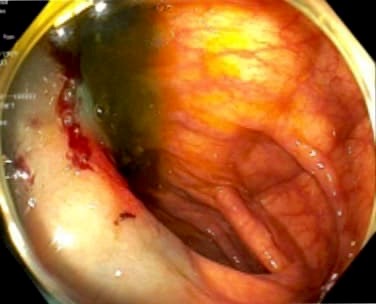Tuesday Poster Session
Category: General Endoscopy
P3411 - A Complication of Viscous Lifting Agents: A Case Report of a Foreign Body Granuloma
Tuesday, October 24, 2023
10:30 AM - 4:00 PM PT
Location: Exhibit Hall

Has Audio

Jarin Prasa, DO
Staten Island University Hospital
Brooklyn, NY
Presenting Author(s)
Jarin Prasa, DO1, Syed S. Karim, DO2, Mohammad Choudhry, MD3, Christopher Chum, DO4, Pratap Gadangi, MD3
1Staten Island University Hospital, Brooklyn, NY; 2NYC Health + Hospitals South Brooklyn Health, Glen Oaks, NY; 3NYC Health + Hospitals, South Brooklyn Health, Brooklyn, NY; 4NYCHHC South Brooklyn Health, Brooklyn, NY
Introduction: Viscous lifting agents are used to elevate polyps during endoscopic mucosal resections (EMR). Although extremely rare, recent cases have linked Orise™, a commonly used lifting agent, to the development of foreign body granulomas. These reactions can lead to errors in diagnosis and unnecessary interventions. We present such a case and urge clinicians to stay vigilant of the potential complications associated with lifting agents in general during EMR procedures.
Case Description/Methods: A 68-year-old man with hypertension underwent a screening colonoscopy. He was found to be healthy and asymptomatic with a normal physical exam. His family history revealed no known cases of gastrointestinal diseases, including IBD or GI malignancies, except for a brother who died of an unknown cancer. Colonoscopy revealed 3 tubular adenomatous polyps and a 12 mm flat adenomatous polyp near the ileocecal valve; an attempt was made to remove it using EMR. During the procedure, the polyp was lifted with Orise™ and was incompletely removed using a hot snare. Due to the nature of the polyp, the patient underwent a right hemicolectomy. Upon review of the surgical histopathology, a granuloma was found, composed of macrophages, multinucleated giant cells, and filled with a homogenous pink material. It was determined to be a tissue reaction to the injecting agent within the submucosa rather than IBD or another diagnosis. Post-surgery, the patient is doing well with no complaints.
Discussion: EMR involves lifting polyps within the GI tract by injecting an agent into the submucosa in order to provide a safe cushion prior to resection. Orise™ was approved by the FDA in 2018 as a lifting agent. Our patient’s surgical pathology showing a granuloma was a surprise. However, due to his lack of symptoms and family history, the finding was determined to be a reaction to Orise™ rather than any common causes of granulomas within the GI tract, such as Crohn’s disease. The emergence of cases associating Orise™ with granulomatous reactions in the gastrointestinal tract over the past few years led to its recall from the market, forcing endoscopists to seek alternative lifting agents. However, it remains unclear whether these agents can also trigger comparable reactions, given their prior limited use in comparison to Orise™. Consequently, clinicians must be aware that lifting agents, in general, can provoke granulomatous reactions and exercise caution when interpreting pathological findings to prevent misdiagnosis.

Disclosures:
Jarin Prasa, DO1, Syed S. Karim, DO2, Mohammad Choudhry, MD3, Christopher Chum, DO4, Pratap Gadangi, MD3. P3411 - A Complication of Viscous Lifting Agents: A Case Report of a Foreign Body Granuloma, ACG 2023 Annual Scientific Meeting Abstracts. Vancouver, BC, Canada: American College of Gastroenterology.
1Staten Island University Hospital, Brooklyn, NY; 2NYC Health + Hospitals South Brooklyn Health, Glen Oaks, NY; 3NYC Health + Hospitals, South Brooklyn Health, Brooklyn, NY; 4NYCHHC South Brooklyn Health, Brooklyn, NY
Introduction: Viscous lifting agents are used to elevate polyps during endoscopic mucosal resections (EMR). Although extremely rare, recent cases have linked Orise™, a commonly used lifting agent, to the development of foreign body granulomas. These reactions can lead to errors in diagnosis and unnecessary interventions. We present such a case and urge clinicians to stay vigilant of the potential complications associated with lifting agents in general during EMR procedures.
Case Description/Methods: A 68-year-old man with hypertension underwent a screening colonoscopy. He was found to be healthy and asymptomatic with a normal physical exam. His family history revealed no known cases of gastrointestinal diseases, including IBD or GI malignancies, except for a brother who died of an unknown cancer. Colonoscopy revealed 3 tubular adenomatous polyps and a 12 mm flat adenomatous polyp near the ileocecal valve; an attempt was made to remove it using EMR. During the procedure, the polyp was lifted with Orise™ and was incompletely removed using a hot snare. Due to the nature of the polyp, the patient underwent a right hemicolectomy. Upon review of the surgical histopathology, a granuloma was found, composed of macrophages, multinucleated giant cells, and filled with a homogenous pink material. It was determined to be a tissue reaction to the injecting agent within the submucosa rather than IBD or another diagnosis. Post-surgery, the patient is doing well with no complaints.
Discussion: EMR involves lifting polyps within the GI tract by injecting an agent into the submucosa in order to provide a safe cushion prior to resection. Orise™ was approved by the FDA in 2018 as a lifting agent. Our patient’s surgical pathology showing a granuloma was a surprise. However, due to his lack of symptoms and family history, the finding was determined to be a reaction to Orise™ rather than any common causes of granulomas within the GI tract, such as Crohn’s disease. The emergence of cases associating Orise™ with granulomatous reactions in the gastrointestinal tract over the past few years led to its recall from the market, forcing endoscopists to seek alternative lifting agents. However, it remains unclear whether these agents can also trigger comparable reactions, given their prior limited use in comparison to Orise™. Consequently, clinicians must be aware that lifting agents, in general, can provoke granulomatous reactions and exercise caution when interpreting pathological findings to prevent misdiagnosis.

Figure: Figure 1: Endoscopic view of a 12mm flat adenomatous polyp in the ascending colon, close to the ileocecal valve after the administration of Orise™ for lifting before hot snare polypectomy.
Disclosures:
Jarin Prasa indicated no relevant financial relationships.
Syed Karim indicated no relevant financial relationships.
Mohammad Choudhry indicated no relevant financial relationships.
Christopher Chum indicated no relevant financial relationships.
Pratap Gadangi indicated no relevant financial relationships.
Jarin Prasa, DO1, Syed S. Karim, DO2, Mohammad Choudhry, MD3, Christopher Chum, DO4, Pratap Gadangi, MD3. P3411 - A Complication of Viscous Lifting Agents: A Case Report of a Foreign Body Granuloma, ACG 2023 Annual Scientific Meeting Abstracts. Vancouver, BC, Canada: American College of Gastroenterology.
